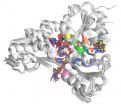(Press-News.org) In a modern, multicore chip, every core -- or processor -- has its own small memory cache, where it stores frequently used data. But the chip also has a larger, shared cache, which all the cores can access.
If one core tries to update data in the shared cache, other cores working on the same data need to know. So the shared cache keeps a directory of which cores have copies of which data.
That directory takes up a significant chunk of memory: In a 64-core chip, it might be 12 percent of the shared cache. And that percentage will only increase with the core count. Envisioned chips with 128, 256, or even 1,000 cores will need a more efficient way of maintaining cache coherence.
At the International Conference on Parallel Architectures and Compilation Techniques in October, MIT researchers unveil the first fundamentally new approach to cache coherence in more than three decades. Whereas with existing techniques, the directory's memory allotment increases in direct proportion to the number of cores, with the new approach, it increases according to the logarithm of the number of cores.
In a 128-core chip, that means that the new technique would require only one-third as much memory as its predecessor. With Intel set to release a 72-core high-performance chip in the near future, that's a more than hypothetical advantage. But with a 256-core chip, the space savings rises to 80 percent, and with a 1,000-core chip, 96 percent.
When multiple cores are simply reading data stored at the same location, there's no problem. Conflicts arise only when one of the cores needs to update the shared data. With a directory system, the chip looks up which cores are working on that data and sends them messages invalidating their locally stored copies of it.
"Directories guarantee that when a write happens, no stale copies of the data exist," says Xiangyao Yu, an MIT graduate student in electrical engineering and computer science and first author on the new paper. "After this write happens, no read to the previous version should happen. So this write is ordered after all the previous reads in physical-time order."
Time travel
What Yu and his thesis advisor -- Srini Devadas, the Edwin Sibley Webster Professor in MIT's Department of Electrical Engineering and Computer Science -- realized was that the physical-time order of distributed computations doesn't really matter, so long as their logical-time order is preserved. That is, core A can keep working away on a piece of data that core B has since overwritten, provided that the rest of the system treats core A's work as having preceded core B's.
The ingenuity of Yu and Devadas' approach is in finding a simple and efficient means of enforcing a global logical-time ordering. "What we do is we just assign time stamps to each operation, and we make sure that all the operations follow that time stamp order," Yu says.
With Yu and Devadas' system, each core has its own counter, and each data item in memory has an associated counter, too. When a program launches, all the counters are set to zero. When a core reads a piece of data, it takes out a "lease" on it, meaning that it increments the data item's counter to, say, 10. As long as the core's internal counter doesn't exceed 10, its copy of the data is valid. (The particular numbers don't matter much; what matters is their relative value.)
When a core needs to overwrite the data, however, it takes "ownership" of it. Other cores can continue working on their locally stored copies of the data, but if they want to extend their leases, they have to coordinate with the data item's owner. The core that's doing the writing increments its internal counter to a value that's higher than the last value of the data item's counter.
Say, for instance, that cores A through D have all read the same data, setting their internal counters to 1 and incrementing the data's counter to 10. Core E needs to overwrite the data, so it takes ownership of it and sets its internal counter to 11. Its internal counter now designates it as operating at a later logical time than the other cores: They're way back at 1, and it's ahead at 11. The idea of leaping forward in time is what gives the system its name -- Tardis, after the time-traveling spaceship of the British science fiction hero Dr. Who.
Now, if core A tries to take out a new lease on the data, it will find it owned by core E, to which it sends a message. Core E writes the data back to the shared cache, and core A reads it, incrementing its internal counter to 11 or higher.
Unexplored potential
In addition to saving space in memory, Tardis also eliminates the need to broadcast invalidation messages to all the cores that are sharing a data item. In massively multicore chips, Yu says, this could lead to performance improvements as well. "We didn't see performance gains from that in these experiments," Yu says. "But that may depend on the benchmarks" -- the industry-standard programs on which Yu and Devadas tested Tardis. "They're highly optimized, so maybe they already removed this bottleneck," Yu says.
INFORMATION:
Additional background
ARCHIVE:
Shoring up Tor
ARCHIVE:
Cloud security reaches silicon
ARCHIVE:
Smarter caching
MADISON, Wis. -- Working in a cave complex deep beneath South Africa's Malmani dolomites, an international team of scientists has brought to light an unprecedented trove of hominin fossils -- more than 1,500 well-preserved bones and teeth -- representing the largest, most complete set of such remains found to date in Africa.
The discovery of the fossils, cached in a barely accessible chamber in a subterranean labyrinth not far from Johannesburg, adds a new branch to the human family tree, a creature dubbed Homo naledi.
The remains, scientists believe, could only have ...
Bethesda, MD (Sept. 10, 2015) --All colorectal cancer patients should undergo tumor testing to see if they carry Lynch syndrome, the most common inherited cause of colorectal cancer, according to a new guideline1 published in Gastroenterology, the official journal of the American Gastroenterological Association.
"Approximately 50,000 Americans are expected to die from colorectal cancer this year, and hereditary syndromes account for a small, but important fraction of those diagnoses," said Joel H. Rubenstein, MD, AGAF, lead author of the guideline, research scientist ...
A new study of more than 500 Black and Latino college students has confirmed that many encounter obstacles after enrolling in college without adequate financial resources.
"Students were surveyed in the fall, winter and spring of freshman year," said Micere Keels, associate professor in comparative human development at the University of Chicago, who led the study. "At each time-point, approximately 35 percent reported having difficulty paying their bills, being upset that they did not have enough money and being concerned that they would not be able to afford to complete ...
Amsterdam, September 10, 2015 - Surgery to remove the breasts of women at increased risk of developing breast cancer may not be necessary in the future, according to research published in EBioMedicine. Two new studies looking at the effect the menstrual cycle has on the development of breast and ovarian cancer reveal alternative prevention strategies that may render surgery unnecessary.
Breast cancer is the most common cancer in women worldwide and ovarian cancer is the deadliest gynaecological cancer. Women who have inherited mutations in genes called BRCA1 and BRCA2 ...
The discovery of a new species of human relative was announced today, 10 September 2015, by the University of the Witwatersrand (Wits University), the National Geographic Society and the Department of Science and Technology (DST) and the National Research Foundation of South Africa (NRF).
Besides shedding light on the origins and diversity of our genus, the new species, Homo naledi, appears to have intentionally deposited bodies of its dead in a remote cave chamber, a behaviour previously thought limited to humans.
Consisting of more than 1 550 numbered fossil elements, ...
An accident waiting to happen: that's what an intoxicated driver is whose attention is further distracted by anything from a text message to dashboard controls. Such distractions are just too much to handle safely, even for people who drive while still within the legal alcohol limits, say Nicholas van Dyke and Mark Fillmore of the University of Kentucky in the US. Their study provides some of the first evidence on the degree to which distractions influence the ability of intoxicated drivers to safely control their vehicles. The findings are published in Springer's journal ...
James Cook University scientists have played a role in a discovery that may alter the known history of humankind.
JCU's Professor Paul Dirks and Dr Eric Roberts were part of a team that explored the Rising Star Cave system in South Africa.
A chamber deep in the caves was found to contain multiple specimens of what is being called Homo naledi - an extinct, previously unknown species related to modern homosapiens.
Testing at JCU and the University of Johannesburg shows sediments in the chamber did not come from external sources, ruling out the possibility of flash ...
Researchers at EMBL's European Bioinformatics Institute (EMBL-EBI) have developed a new method for studying the targets and effects of cancer drugs using data from discovery mass spectrometry (MS) experiments. The study is published in Nature Communications.
Understanding the biological signaling pathways that regulate metabolism and gene expression is challenging, because so many things are happening at once. But this understanding is crucial for knowing how a drug will affect healthy and cancer cells. Protein kinases play a pivotal role in these pathways by turning ...
NS3 is an enzyme specific to the hepatitis C virus. If developed, a drug capable of recognizing and selectively attacking it could fight the disease without side effects for the body. However, to be able to develop one we need to know more about the behavior of this important protein in the virus replication process. Some SISSA scientists have provided a detailed and comprehensive view of the behavior of NS3. The study has been published in the journal Nucleic Acids Research.
According to the WHO, a good 140 million people are affected by hepatitis C (3/4 million new cases ...
While sexual contact is not the most efficient means of hepatitis C (HCV) transmission, there have been several reports of outbreaks of sexually transmitted HCV in HIV-positive men who have sex with men (MSM). HCV infections are more likely to become persistent and to lead to progressive liver disease in people who are HIV-infected, even if they are receiving HIV treatment. Factors underlying these infections in HIV-positive MSM are only partially understood.
Researchers at NYU's Center for Drug Use and HIV Research (CDUHR) at the College of Nursing (NYUCN) have conducted ...

